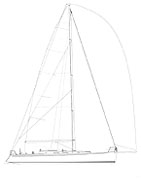J/145
Racer-cruiser
The key to this combination is a low VCG made possible by a cast nickel-aluminum-bronze keel fin with a lead bulb on the bottom. The ballast-to-displacement ratio is 44 percent, and a draft of 8 feet, 11 inches results in a VCG 2 percent below the DWL. The 145 uses this VCG to get a limit of positive stability of 135 degrees. In the last two years we have seen limits of positive stability for racing boats far in excess of what is considered adequate for cruising boats. Everyone likes stability. It translates directly to sail carrying power.
The hull form of the 145 features a midsection with a surprising amount of deadrise. The hull is relatively narrow with the max beam carried forward in an effort to make the boat more benign when pushed hard off the wind. This is not a shape you would see on a current IMS type of hull with an ultrafine entry. Deadrise fairs out to a flattish run aft. The rudder is huge. You can choose a shoal-draft keel option with 7-foot draft. The D/L of this design is 110.
This is a very interesting interior layout. Note the V-berth/double pushed forward, leaving a large sail stowage area directly forward of the mast. Aft of this, the layout is conventional with a pilot berth to port, outboard of the opposing settee berths. The galley is big, but I would have turned the icebox 90 degrees to allow the range to come forward, providing counter space each side. It's a personal taste thing, but I do a lot of cooking and I know galleys. I surprised last week's crew with my super three-cheese lasagna. Nitpicking aside, this is a great layout. Numerous options are available if you want to "plush up" the interior.
This is a big rig. The SA/D is 29. The spreaders are minimally swept, and runners and checkstays will be needed to keep the standard Hall Spars carbon stick in column. The mainsail is raised on a 2:1 halyard. The bowsprit is retractable. The sailplan shows overlapping genoas, but for cruising, a 95-percent blade jib would be enough to allow you to blow away almost any other cruising boat.
I have been a long-time fan of J Boat's decks. They seem to suit my own sailing style to a T, and the 145 is no exception. The cockpit is long and has seats long enough to stretch out on. The coamings are low and that could be a problem for lounging, but they will make getting in and out of the cockpit easy. I like a low coaming at the wheel, but I like at least 12-inch coamings forward.
The 145 is built in TPI's patented Scrimp method with unidirectional carbon and E-glass skins over Baltek's Superlight 45 core. The engine is a 56-horsepower Yanmar 4JH3CE with a saildrive unit. There is tankage for 90 gallons of water in two tanks and 75 gallons of fuel.
Designer Rod Johnstone has given us a J Boat cruiser that in focus is not far from my own Icon design. As Bill Lee once said: "Fast is fun."

Comments